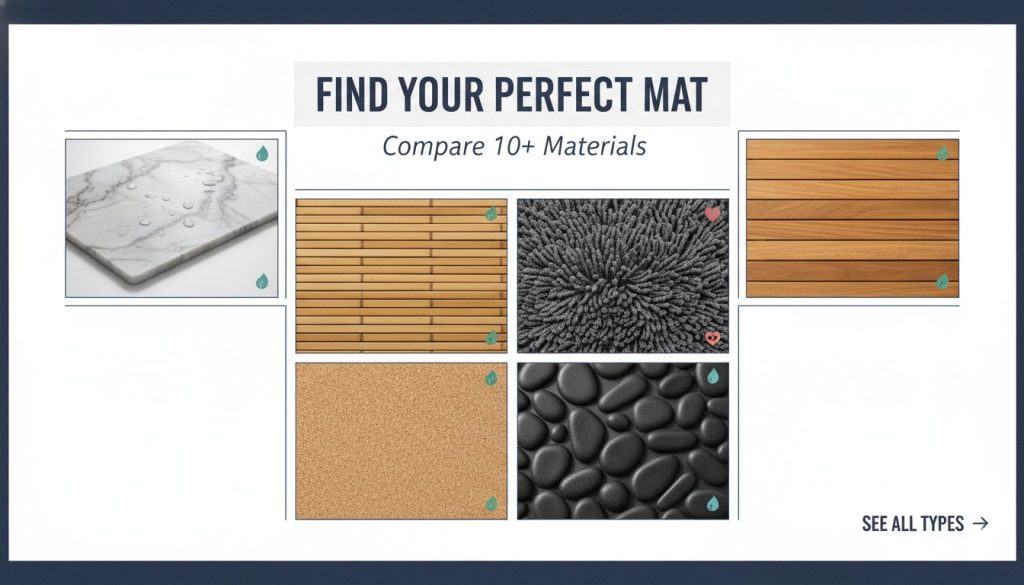
‘ll be honest—I never thought much about bath mats until I stepped out of the shower one morning and realized my old one had seen better days. It was flat, dingy, and honestly kind of gross. That’s when I started down the rabbit hole of discovering just how many options exist out there. After trying nearly every type of mat available, I’ve learned that choosing the right one can genuinely transform your daily routine. Let me walk you through what I’ve discovered so you can avoid my years of trial and error.
Introduction: Why Your Bath Mat Actually Matters
When you think about bathroom essentials, bath mats might not be the first thing that comes to mind. But here’s the thing—you interact with your mat every single day, sometimes multiple times. It’s one of the few purchases that directly impacts your comfort, safety, and even your bathroom’s overall vibe. A good bath mat keeps you from slipping, absorbs water efficiently, and honestly makes stepping out of the shower feel like a small luxury rather than a chilly inconvenience.
Beyond the practical side, your mat sets the tone for your entire bathroom aesthetic. Whether you’re going for spa-like sophistication or practical minimalism, the right mat choice can either elevate or undermine your design vision. And then there’s the maintenance factor—some mats practically clean themselves while others demand constant attention. Over the next few sections, I’ll walk you through every major option out there so you can make an informed decision based on your lifestyle, budget, and bathroom style.
Natural Stone Options for Durability and Elegance
What Is a Stone Bath Mat?
When I first encountered a genuine stone bath mat at a luxury hotel, I was fascinated. A stone bath mat is essentially a slab of natural stone—typically marble, travertine, or slate—designed specifically to be water-resistant and durable enough for bathroom use. Unlike traditional fabric mats, these are solid, heavy, and built to last for years.
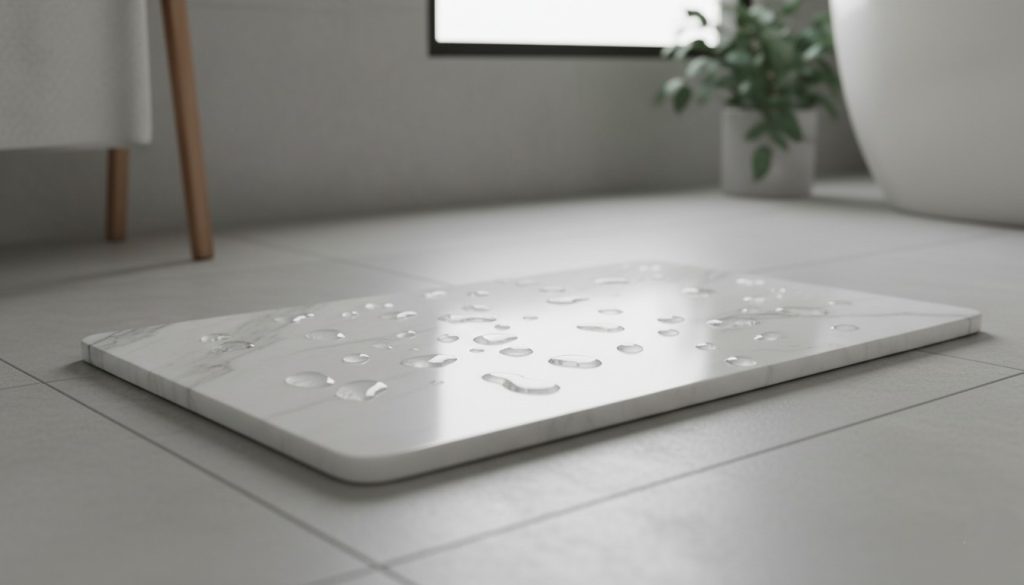
What drew me to stone mats was their thermal properties. Sounds weird, I know, but there’s something genuinely pleasant about stepping onto cool stone after a hot shower. It’s like bringing a spa experience into your own bathroom. The mat stays firm and doesn’t compress or wear down like fabric mats do. I’ve seen the same stone mat in pristine condition after five years of daily use—try saying that about most fabric options.
The downsides are real, though. Stone mats are heavy, which makes them difficult to move or clean. They’re also cold if your bathroom isn’t heated, and they can be genuinely slippery when wet unless you choose a textured finish. Plus, there’s the price tag—we’re talking $100 to $300 for a quality stone mat, depending on the material. And if you have young kids, dropping something on a stone mat won’t end well for the item or potentially the mat itself.
Why Stone Appeals to Bathroom Designers
Stone mats are less about practicality and more about making a statement. If you have a luxury bathroom aesthetic going on—think marble countertops, high-end fixtures, and a spa-inspired vibe—a stone mat is the finishing touch that ties everything together. It signals intentionality and investment in your space.
The key to making a stone mat work is ensuring proper drainage underneath it. I learned this the hard way when moisture started accumulating under mine. Now I make sure to wipe underneath it occasionally and ensure there’s adequate airflow. It’s an extra step, but it keeps the mat looking great and prevents mildew issues.
Moisture-Absorbing Materials: Science Meets Comfort
What Is a Diatomaceous Earth Bath Mat?
This is where my bath mat journey got interesting. A diatomaceous earth bath mat is made from fossilized diatoms—tiny aquatic organisms that have been compressed over millions of years. The result? A material that’s incredibly porous and absorbs water like nothing I’ve ever seen before.
I picked one up out of pure curiosity and was blown away. Within seconds of stepping out of the shower, the mat had absorbed all the water from my feet and the surrounding area. It’s genuinely impressive. The mat feels slightly gritty and has a natural, earthy appearance that works surprisingly well in modern bathrooms.
Here’s what really sold me: it’s naturally antimicrobial. Unlike fabric mats that can develop that musty smell, diatomaceous earth resists odors. Plus, it dries incredibly quickly, which means mildew and bacteria struggle to take hold. As someone who values low-maintenance products, this was huge for me.
The trade-off? Diatomaceous earth mats are fragile. Drop something heavy on them or step on them wrong and you risk cracking or chipping. They also require specific care—you need to avoid harsh cleaners and excessive moisture can eventually wear them down. They’re also slightly more expensive than standard fabric mats but significantly cheaper than stone. If you want the spa experience without the commitment of stone, this is a solid middle ground.
What Is Memory Foam Bath Mat?
Memory foam mats took me by surprise because I initially dismissed them as gimmicky. But after testing one, I genuinely appreciated what they offered—pure comfort.
A memory foam bath mat is exactly what it sounds like: a mat with a memory foam base similar to what’s in premium mattresses. When you step on it, the foam compresses and then slowly returns to its original shape. If you have back or foot pain, this can be genuinely relieving, especially if you spend time standing in front of the mirror getting ready.
The softness underfoot is undeniable. My morning routine became slightly more enjoyable just because stepping out of the shower felt like stepping onto a cloud. Memory foam also provides decent grip, and the mat itself is quite absorbent thanks to the textile covering.
However, memory foam has limitations. It doesn’t last as long as other options—after about two years, you’ll start noticing it doesn’t bounce back quite like it used to. It also requires regular machine washing to stay fresh, and if you have a really wet bathroom environment, excess moisture can degrade the foam over time. Plus, they’re heavier than you’d expect, so moving them around for cleaning can be annoying.
Eco-Friendly and Sustainable Wood-Based Materials
Bamboo Bath Mats: The Renewable Option
I became obsessed with bamboo mats after learning about how quickly bamboo grows. Unlike trees that take decades to mature, bamboo reaches full size in just a few years. This makes bamboo mats genuinely one of the most sustainable options available.
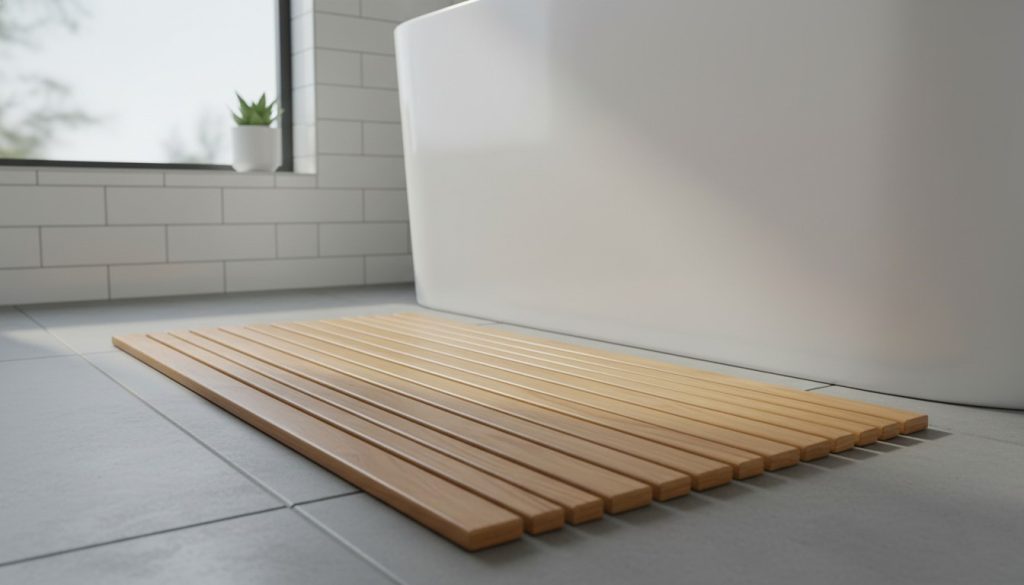
What surprised me was how well bamboo performs functionally. It has natural antibacterial properties, which means it resists odors without smelling chemical-heavy like some other mats. Bamboo is also naturally water-resistant, so it doesn’t absorb water like fabric mats do. This means it dries quickly and resists mildew effectively.
The aesthetic is excellent too. Bamboo has a warm, natural look that works in contemporary, minimalist, and even transitional bathroom styles. It feels premium without looking pretentious. And price-wise, you’re getting quality at a reasonable cost—usually $40 to $80 for a decent bamboo mat.
The catch? Bamboo can be slippery when wet, so many come with rubber backing to solve this problem. Also, if you live in a very humid climate, the wood can eventually warp. I’ve learned to ensure mine dries completely and to avoid storing it in extremely damp conditions.
Cork Bath Mats: Nature’s Sustainable Alternative
Cork mats fascinated me because cork is harvested without harming the tree—they strip the bark and it grows back over time. For anyone concerned about environmental impact, cork is genuinely a feel-good choice.
The first thing you notice about cork is the texture. It’s naturally grippy, which means you’re significantly less likely to slip when wet. This is a huge advantage over stone or some wood options. Cork is also naturally antimicrobial and hypoallergenic, so it’s an excellent choice if you have sensitivities or allergies.
Aesthetically, cork has this warm, organic appeal that makes your bathroom feel more natural and spa-like. It’s not cold like stone, and it has more character than some fabric mats. The price point is usually in that sweet spot—affordable but not cheap.
Where cork disappointed me slightly is durability. After about three years of regular use, mine started showing significant wear at the edges. The surface also requires occasional oiling to maintain its condition and water resistance. It’s not difficult, but it’s an extra step you need to commit to.
Wooden Bath Mats and the Teak Advantage
I wanted to explore all wood options, so I tested several varieties. Wooden bath mats range dramatically in quality depending on the type of wood used.
Wooden Bath Mats: General Overview
Standard wooden mats made from softer woods like pine or cedar can be problematic. They absorb water, swell, and eventually develop splinters or soft spots. I had one that started falling apart within two years despite my best maintenance efforts.
Teak Bath Mats: The Gold Standard
Then I tried teak, and I understood why luxury hotels and spas use it. Teak is a hardwood that naturally contains oils making it incredibly water-resistant. It’s dense enough that it doesn’t absorb water like softer woods, and these oils actually improve with age rather than diminishing.
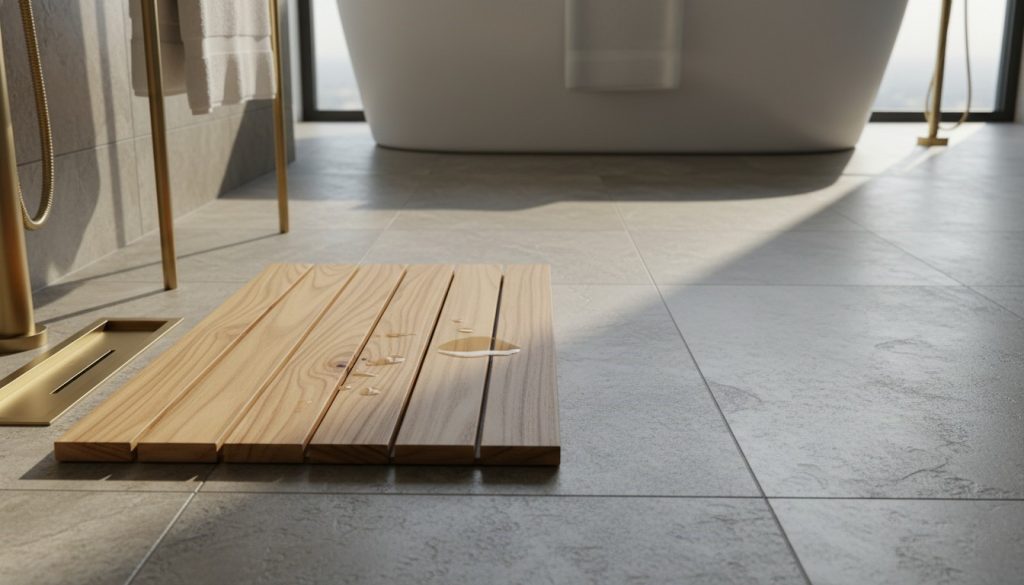
My teak mat is genuinely beautiful. It has this warm, honey-colored tone that adds genuine luxury to my bathroom. It looks like an intentional design element rather than a utilitarian purchase. And unlike some of my other mats that I’ve had to replace, I can see my teak mat lasting a decade or more.
The serious downside is price. Teak mats easily cost $150 to $400 depending on size and quality. It’s a significant investment. Also, teak requires regular maintenance—you need to oil it periodically to maintain water resistance and keep it looking its best. Some people love this ritual; others find it tedious. For me, it’s worth it because the mat is genuinely beautiful and functional.
Comparing wooden options, teak is in a completely different category from budget wood mats. If you’re just looking for something functional, standard wood isn’t worth it. But if you’re investing in a premium option that will last years, teak is exceptional.
Moss Bath Mats: The Unconventional Choice
This is the one I included partly out of curiosity and partly because it genuinely deserves mention. A moss bath mat uses actual living moss or preserved moss to create something between a functional mat and a decorative art piece.
Living moss mats are genuinely unique. They’re soft, naturally antimicrobial, and look absolutely stunning in the right bathroom. They’re also incredibly eco-conscious. However, they require specific care—they need moisture (but not waterlogging), indirect light, and regular misting. It’s basically like maintaining a small plant in your bathroom.
Preserved moss mats are lower maintenance but lose some of the living aesthetic. They still look beautiful but don’t require the same level of care.
Honestly? These are more about making a design statement than serving a purely practical purpose. I appreciate them as an art piece more than as an everyday functional mat. But if you have a modern, design-forward bathroom and you’re willing to commit to care requirements, a moss mat is genuinely conversation-starting.
Synthetic and Practical Materials for Modern Bathrooms
Rubber Bath Mats: The Practical Workhorse
I’ve always had a rubber mat in my collection because sometimes you just need something that works without overthinking it. Rubber mats are the practical backbone of the bath mat world.
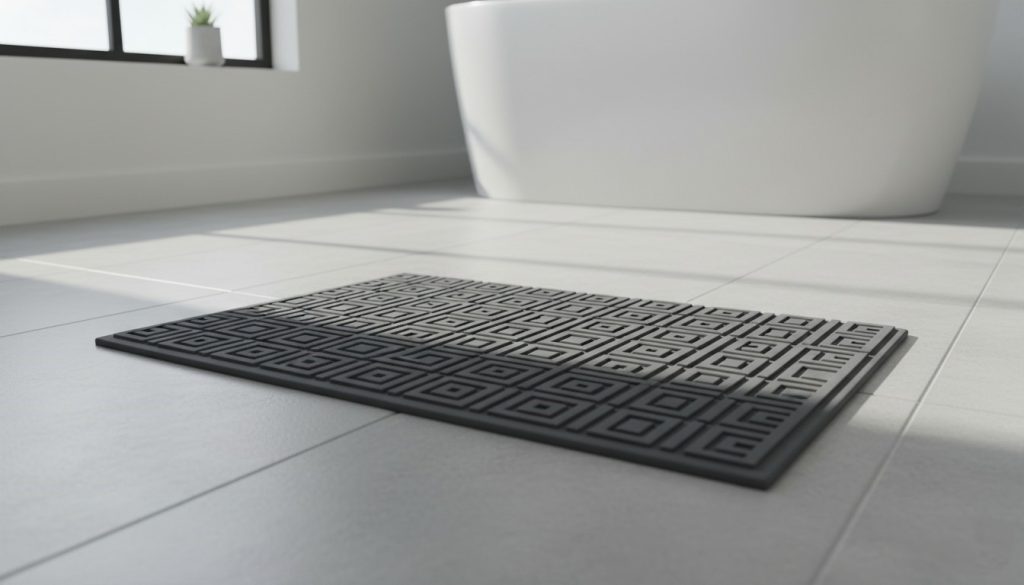
Rubber’s primary strength is slip resistance. The textured surface grips your wet feet reliably, which means you’re not doing that awkward wobbling shuffle out of the shower. If safety is your priority—maybe you have kids or elderly family members—rubber’s grip is genuinely superior to most other options.
Cleaning is effortless. Throw it in the washing machine or hose it down outside, and it’s clean. Rubber is also incredibly durable and affordable—a good rubber mat costs $15 to $40 and will last years. There’s no mystery or maintenance ritual required.
The aesthetic limitations are real, though. Rubber mats look utilitarian, and frankly, they look cheap even when they’re not. If you’re trying to create an elegant bathroom aesthetic, rubber works against your goals. They can also develop a slight smell if they’re consistently wet, and in humid climates, they’re prone to mildew. I keep mine in my guest bathroom where aesthetics matter less and I want low-maintenance reliability.
Microfiber Bath Mats: Engineered for Comfort and Functionality
If you want the best of both worlds—something that looks and feels nice while actually performing well—microfiber is probably your answer. My primary mat has been microfiber for the last couple of years, and I keep coming back to it.
Microfiber is basically tiny synthetic fibers woven together, and the result is remarkable absorbency. My microfiber mat soaks up water faster than most fabric mats I’ve tried. It dries relatively quickly too, which means mildew isn’t usually an issue. The texture is also wonderfully soft underfoot—genuinely luxurious without being impractical like memory foam.
What I love most is how well microfiber accepts dyes and patterns. You can get beautiful, vibrant colors and designs that hold up wash after wash. And speaking of washing, microfiber is machine-washable without any special requirements. I wash mine every couple of weeks and it looks like new.
The price is fantastic too. You can get a high-quality microfiber mat for $25 to $60. That’s affordable luxury. Comparing this to teak or stone, you’re getting 80% of the luxury feel at maybe 20% of the cost.
The real limitation is longevity. After about three to four years, my microfiber mats start showing wear—they’re not as plush, and the colors fade slightly. But given the affordable price point, replacing it every few years isn’t a financial burden. Plus, the low cost means you can actually buy multiple mats for different bathrooms without guilt.
Comparison Guide: Making Your Decision
By now, you’re probably wondering which mat actually makes sense for your situation. Here’s how I think about it:
If You Want Luxury and Durability: Stone or teak are your options. These are investments that will outlast most other mats. Stone gives you that spa aesthetic immediately, while teak offers warmth and beauty that improves with age. The trade-off is cost and maintenance.
If Sustainability Matters to You: Bamboo, cork, and moss are your answers. Bamboo offers the best balance of sustainability, performance, and price. Cork is excellent if grip and natural feel are priorities. Moss is for the design-forward homeowner willing to commit to care.
If Comfort Is Non-Negotiable: Memory foam and microfiber lead here. Memory foam provides ergonomic support, though it won’t last as long. Microfiber gives you softness, absorbency, and longevity at an accessible price.
If Practicality Wins: Rubber and microfiber are your reliable choices. Rubber if safety and ease of cleaning matter most. Microfiber if you want practicality without sacrificing aesthetics.
The Decision-Making Framework
Before you buy, think through a few specifics about your situation:
Your Bathroom Style: What’s the overall aesthetic you’re going for? A modern, minimalist bathroom might call for sleek bamboo or cork. A luxury spa vibe demands stone or teak. A practical, family bathroom needs rubber or microfiber.
Moisture and Humidity: Do you have a small bathroom that steams up, or a well-ventilated space? High-humidity bathrooms need mats that resist mildew—diatomaceous earth, cork, bamboo, and microfiber handle this well. Avoid memory foam and standard wood in humid environments.
Your Lifestyle: Are you someone who loves maintenance rituals and caring for items, or do you prefer set-it-and-forget-it options? Teak and cork require occasional maintenance. Rubber and microfiber are hands-off.
Your Budget: Honestly, there’s an option at every price point. Rubber and microfiber offer tremendous value under $60. Mid-range options like bamboo, cork, and diatomaceous earth run $60 to $120. Premium options like stone and teak are $120 and up.
Your Values: If environmental impact matters, lean toward sustainable options. If longevity is the priority, invest in premium materials. If you want something that looks intentional and beautiful, consider stone, teak, or high-quality cork.
Maintenance and Care Overview
The best mat is one you’ll actually care for properly. Here’s what I’ve learned about keeping different mats in good condition:
Stone: Wipe dry after heavy use. Occasionally clean with pH-neutral stone cleaner. Ensure drainage underneath to prevent mold growth. Minimal effort overall, but consistency matters.
Memory Foam: Machine wash regularly on gentle cycle. Air dry completely—this is crucial. Don’t saturate it excessively during cleaning. Replace every 2-3 years as performance degrades.
Bamboo: Wipe dry after each use. Occasionally wash with mild soap and water. Avoid prolonged saturation. Check for splinters annually, especially at edges.
Cork: Wash occasionally with mild soap. Allow to dry completely. Oil every 6-12 months with food-grade mineral oil to maintain water resistance and appearance.
Teak: Occasionally wipe with a damp cloth. Oil every 6 months with teak oil to maintain water resistance and color. The more you care for it, the more beautiful it becomes.
Rubber: Machine wash or hose clean as needed. Air dry. Replace if you notice degradation or smell issues. Lowest maintenance option overall.
Microfiber: Machine wash every 2-4 weeks. Air dry for longevity (or use low heat). This frequent washing keeps it looking and smelling fresh.
Conclusion: Choosing What’s Right for You
After testing nearly every type of bath mat available, I’ve come to appreciate that there’s no universally “best” option. The best mat for you depends entirely on your specific situation, preferences, and priorities.
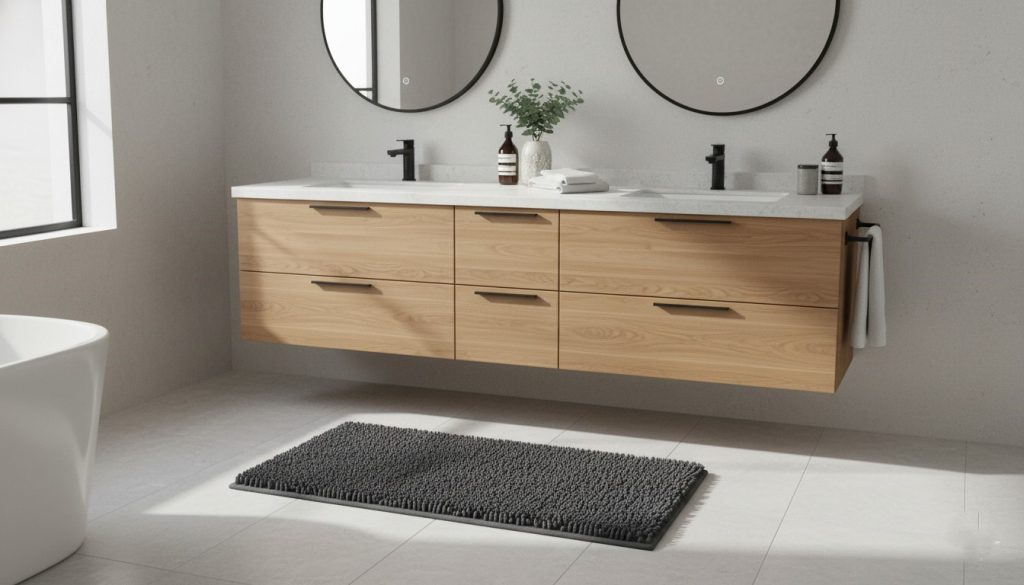
What I’ve learned is that investing in the right mat is genuinely worth it. Whether you choose something practical and affordable like microfiber, or you splurge on beautiful teak, the difference in your daily experience is noticeable. You interact with your bath mat every single day, and when it’s the right one for your lifestyle, it makes those mundane moments slightly more pleasant.
Take time to think about what matters most to you—is it slip resistance? Eco-friendliness? Luxury feel? Longevity? Once you know your priority, the choice becomes much clearer. And remember, you don’t have to stick with one mat forever. I’ve had mats that worked perfectly for a season of my life before I moved on to something different. That’s part of the journey of figuring out what genuinely works for you.
Whatever you choose, commit to caring for it properly. A well-maintained mat will perform better and last longer, turning what could be a throwaway purchase into something you actually enjoy using day after day.
Leave a Reply